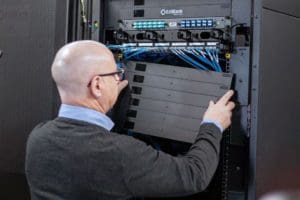Data center blanking panels are an essential investment for any facility looking to enhance efficiency and reduce energy costs. At EziBlank, we understand that optimal airflow management is key to maximising performance and maintaining your infrastructure’s integrity. Our innovative blanking panels are quick and easy to install, providing a seamless solution that not only optimises your energy consumption but also protects your core knowledge assets. Experience a significant improvement in your data centre’s operational effectiveness with EziBlank’s advanced technology tailored to your needs.
The Role of Blanking Panels in Energy Efficiency
Blanking panels may seem like a minor component within data centres, but their role in enhancing energy efficiency is substantial. By effectively sealing unused spaces in server racks, these panels prevent the mixing of hot and cold air, allowing cooling systems to operate more efficiently. This targeted airflow management reduces the overall energy consumption required to maintain optimal temperatures, leading to significant cost savings and a lower carbon footprint. Incorporating blanking panels into data centre infrastructure is a simple yet powerful step towards achieving greater energy efficiency and sustainability.
Read More
Elevate Data Center Performance with Blanking Panels
Enhancing the performance of data centres often hinges on small yet impactful innovations, such as the strategic use of blanking panels. These panels are designed to cover unused spaces in server racks, preventing hot air from recirculating and ensuring that cooling systems work at peak efficiency. By improving airflow management, blanking panels help maintain optimal operating conditions for servers, reducing the risk of overheating and boosting overall system performance. For data centres striving to maximise efficiency and reliability, blanking panels offer a straightforward and effective solution.
Read More
Innovative Solutions for Data Center Cooling
Effective cooling solutions are vital for the smooth operation of data centres, where temperature control is critical to maintaining equipment reliability and performance. Various strategies are employed to manage heat, from advanced liquid cooling systems that directly cool high-density servers to traditional air cooling enhanced by precision airflow management. The use of blanking panels is a simple yet powerful method to improve air circulation, preventing hot spots and reducing the workload on cooling systems. By implementing a combination of these cooling technologies, data centres can optimise their energy efficiency, lower operational costs, and ensure that their infrastructure remains robust and reliable.
Read More
Choosing the Right Blanking Panels for Your Data Centre
Selecting the appropriate blanking panels for your data centre is a crucial step in optimising airflow and improving overall energy efficiency. Blanking panels, which fill unused spaces in server racks, are available in various sizes and materials to suit different configurations and needs. Choosing the right panels involves considering factors such as rack dimensions, the type of cooling system in place, and the specific airflow requirements of your equipment. Properly installed blanking panels help prevent hot air recirculation, ensuring that cooling systems operate more effectively, thereby reducing energy consumption and enhancing the performance and longevity of your data centre’s infrastructure.
Read More
Blanking Panels: The Importance of them in Server Racks
Blanking panels play a vital role in maintaining the efficiency and effectiveness of data centre cooling systems. By filling the empty spaces in server racks, these panels prevent the mixing of hot and cold air, ensuring that the cool air is directed where it is needed most—towards the active equipment. This targeted airflow management helps to maintain optimal operating temperatures, reduces the strain on cooling systems, and ultimately leads to lower energy consumption. The use of blanking panels not only improves the performance and longevity of data centre equipment but also contributes to significant cost savings and a more sustainable operation.
Read More
